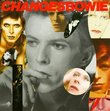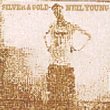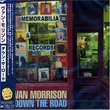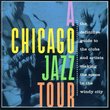| All Artists: Ravi Shankar Title: Full Circle: Carnegie Hall 2000 Members Wishing: 1 Total Copies: 0 Label: Angel Records Release Date: 3/27/2001 Album Type: Live, Original recording remastered Genres: International Music, Pop Styles: Far East & Asia, Reggae, India & Pakistan, India Number of Discs: 1 SwapaCD Credits: 1 UPCs: 724355710628, 0724355710659, 724355710659 |
Search - Ravi Shankar :: Full Circle: Carnegie Hall 2000
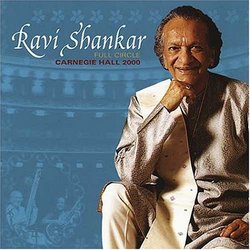 | Ravi Shankar Full Circle: Carnegie Hall 2000 Genres: International Music, Pop
In 1938, 17-year-old Ravi Shankar made his first appearance at New York's famed Carnegie Hall as a dancer and musician in his brother Uday's troupe. After 62 years and countless performances and recordings later, the pr... more » |
Larger Image |
CD DetailsSynopsis
Amazon.com In 1938, 17-year-old Ravi Shankar made his first appearance at New York's famed Carnegie Hall as a dancer and musician in his brother Uday's troupe. After 62 years and countless performances and recordings later, the preeminent sitarist and composer could still wow a New York audience, now with his 19-year-old daughter and protégée Anoushka in tow. These performances of the nighttime raga "Kaushi Kanhara" and the light, romantic "Mishra Gara" indeed make for an evening to remember. Listening to Full Circle is a reminder of Shankar's many compositional innovations. While this is a classical recording, the master introduces elements from outside the Hindustani (i.e., North Indian) tradition--especially his widespread use of harmony in a style that, historically, is completely based on complex interplays of melody and rhythm. His unusual use of two tablas (played here deftly by Bikram Ghosh and Tanmoy Bose) builds additional excitement. And the sheer melodic inventiveness that he displays in these two ragas would be stunning from a performer half his age. Throughout, the honeyed tone and gentle spirit that pervade all of Shankar's recordings, classical or experimental, shine through brilliantly. Kudos to Angel's engineers, too, on making a remarkably full and bright recording that captures all the energy of this live concert. --Anastasia Tsioulcas Similarly Requested CDs
|
CD ReviewsAn inspirational ageless wonder Enrique Torres | San Diegotitlan, Califas | 01/18/2002 (4 out of 5 stars) "Ravi Shankar has played Carnegie Hall numerous times but on this recording it is 62 years after his first performance, hence the title "Full Circle." His lovely daughter, a fine sitar player in her own right, San Diegan Anoushka Shankar, accompanies the master for some memorable playing. To the novice Western ears that are unacustomed to the sitar, the disc begins as though they are tuning their instruments! With a pick here and a lingering note there, the classical Indian music is both a mixture of Eastern mysticism and high energy music that sizzles. All the compositions are by the master sitar player Ravi Shankar and he demosnstrates why he is considered the best at what he does, even at his age(81) he has the dexterity and and stamina to breathe life into the guitar like instrument with incredible intensity. By the time the tablas join in the playing, the group has "warmed up" and the call and response between Ravi and daughter is nothing short of incredible. The complex classical music is explained in full detail in the accompanying insert. The two ragas are broken down into several movements within, allowing for the improvisational skills to play within the discipline of the raga. It was great to revisit the soothing yet exhilirating sounds of Ravi Shankar again and I recommend this disc to old and new fans alike. Try this disc for a trip into the soul of Ravi Shankar as he demonstrates the essence and purity of Eastern music. As explained in the informative booklet, Ravi has achieved Karmasu kausalam or " the purity of purpose, the humble intuitive pursuit of perfection." This is blissfully, joyful music that symblolizes the gifted life of Ravi come full circle, as he passes the torch to his daughter, Anoushka, for a new generation of Shankar music. If you like world music, this has a niche in your musical library, file it under good karma." Melodious and Mesmerizing Rebecca Johnson | Washington State | 02/16/2003 (5 out of 5 stars) ""Because I improvise completely (of course observing all the complex discipline of the raga and tala forms) I feel constrained performing for an audience with the knowledge that it is being recorded for a DC. But luckily this time it worked!" -Ravi Shankar This was my introduction to Ravi Shankar, the famous sitar player born in Benares, India in 1920. He was the first Indian instrumentalist to attain an international reputation. It is interesting to note that in 1962 he founded the Kinnara School of Music in Bombay. In 1965, George Harrison of the Beatles studied sitar with Shankar, and Beatle recordings began featuring Harrison playing the sitar. "Ravi, because of his upbringing and living in Paris and traveling in Europe, could relate to all the musicians, theater people and painters he met in the West. It also made him willing to persevere to reach a mass audience, and led to the future role he would have in really bringing world music to the West." -George Harrison (1943-2001) As a youth, Shankar was a solo dancer who performed with his brother Uday's Indian dance troupe in Paris. He later married Ustad Allauddin Khan's daugher, Annapurna. His own daughter "Anoushka Shankar (1981-), who studied with her father, is also a virtuoso sitarist." See B00000DCI0 for an album by this artist. Here, she joins her father at Carnegie Hall where he first performed as a musician and dancer in 1938. The same year he became a pupil of the great Indian instrumentalist Ustad Allauddin Khan. Among Shankar's many musical compositions are the scores for the motion pictures Pather Panchali (1954) and Apu Trilogy. He has also collaborated with musicians like Zubin Mehta and with composer Philip Glass in their electronic recording "Passages (1990). This is music which is probably still quite exotic for many listeners, but you can be easily seduced into listening if you give the music time to weave its magic spell. As the music progresses you actually can become a bit mesmerized by the sounds of the sitar, tabla and tanpura. The sitar is indigenous to the Indian subcontinent and was actually popularized by Ravi Shankar in the 1960s. It is a fretted string instrument with a gourdlike body and a long neck. It has from 3 to 7 gut strings, tuned in fourths or fifths or both. There is also a lower course of 12 wire strings that vibrate sympathetically with the first set. Shankar believes that a "raga" is an aesthetic projection of an artists inner spirit. This concert presents soothing and exhilarating blends of contemplative raga forms. The Hindu/Urdu word "rag" is derived from the Sanskrit word: "raga." This means color or passion. When you think of raga, think of an acoustic method of "coloring the mind of the listener with emotion." Raga is technically one of the melodic formulas of Hindu music having the melodic shape, rhythm, and ornamentation prescribed by tradition. The characteristics which define raga are: The seven notes (Sa, Re, Ga, Ma, Pa, Dha, Ni) of the Indian musical scale called "swar." The "swar" (notes) are assembled to make the scales. These scales are called "saptak." Modal Structure called "that." There are 32 seven-note combinations of the "swar," yet only ten are conventionally accepted as "thats." Number of notes used in the rag called "jati." A seven-note rag is a "sampurna jati." Ascending and descending structure called: "arohana/avorohana." The "arohana" is the pattern in which a rag ascends the scale. The "avarohana" describes the way a rag descends the scale. Important notes are called "vadi" (a note which is strongly emphasized) and "samavadi." (a note that is strong but only slightly less so). Characteristic movements to the rag called: "pakad" or "swarup." for instance the "Pa M'a Ga Ma Ga" is a sign for Rag Bihag. The Indian Swar (notes) are Sa, Re, Ga, Ma, Pa, Dha, Ni. In addition to the main characteristics of "rag" there are some that are attributed to times of the day. There can also be male and female rags. Tradition dictates that certain rags are performed at certain times of the day, seasons or holidays. Playing rags at the wrong time may bring disharmony. At the right time they may bring harmony. Ravi Shankar has also been awarded an honorary knighthood by the Queen of England. See his autobiographies: My Music, My Life (1969) Raga Mala (1997). Perfect accompaniment to an Indian-inspired dinner or just when you want to take a sound journey. Also perfect for listening to while giving or receiving a massage. ~The Rebecca Review" Broad based appeal Omar Sultan | Elk Grove, CA USA | 04/10/2001 (4 out of 5 stars) "If you are a fan of Ravi Shankar or of Indian music, you will enjoy both the aesthetics and the nostalgia of this disc--Ravi first played Carnagie Hall in 1938.If you have never listened to Indian music before, give this a try, it is mellow yet substantial, quiet yet energizing."
|

 Track Listings (5) - Disc #1
Track Listings (5) - Disc #1